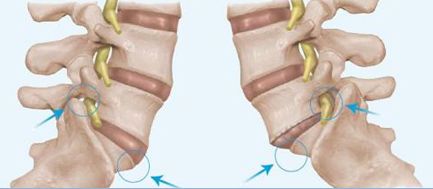The symptoms and treatment of analistas vertebrae of the cervical spine
Antelias C3 – anterior displacement of the cervical vertebrae 3 to 4 (C4). Pathology is rare, therefore, not explored fully enough. The domestic classification of the disease does not account for the 2 types of pathology: stair and combination.

classification and Characteristics
Antelias cervical vertebra C3 is accompanied by the following symptoms:
- Pain in the neck
- Numbness of skin;
- Paresthesia of the upper extremities;
- Loss of sensation of the skin of hands;
- heart palpitations.
European scientists for a long time studied the condition of the spinal cord during the shift of the C2-C6 (cervical segments 2 to 6). The experiments were able to form the following classification pathology:
- Analyses in combination with spondylolysis;
- Degenerative displacement of vertebras;
- Spondylolisthesis static;
- Stair analystes.
Classification is based on x-ray observations of the changes of the cervical spine at levels C2, C3, C4, C5,.
Another form of the disease were not included in clinical classification – pseudolites. The pathology observed on the background of morphological abnormalities in the spinal column. Anatomically the disease is not detected pathological changes of the spinal column (spina arches, nesrastanii of the vertebral bodies).
With the weakness of the muscular frame of vertebral segments during exercise may be a pathological motion of vertebral segments, leading to the infringement of the nerve roots.
If the pseudo analysese almost never observed narrowing of the spinal cord.
Clinical symptoms
Symptoms of anterior displacement C2-C5 (analistas C2-C5) are very dangerous to health and life. Via cervical spine is undergoing a vertebral artery, which supplies blood to about 25% of the brain.
The displacement of the vertebrae (C2, C3, C4, C5) may occur compression of the vessel. If the infringement is expressed, in case of lack of blood supply to the brain a person can lose consciousness. Enough infringement ½ portion of the lumen of vertebral artery to brain hypoxia.
More dangerous-compression C2 than C5. Because of the close proximity of brain tissue, compression of the vessel in this area combined with the sudden cessation of cerebral blood supply.
Congenital oblique location of the intervertebral joints C4-C5 is observed initially deforming arthrosis, which gradually leads to instability of the cervical vertebrae. The basis of analysese are 3 reasons:
- Hypoplasia processes;
- Elongation of the vertebral arch;
- Weakening of the intervertebral disc with osteochondrosis.
The Symptoms greatly depend on the place of infringement of the nerve roots.
The Main symptom of pathology in the segment of C2-C3 is migraine – severe headache that occurs for no apparent reason. The disease is formed due to the lack of blood supply in a cerebral artery.
When instability of the cervical vertebrae C4-C5 in humans is often observed sleep disturbance, runny nose and chronic fatigue. The symptoms appear on the background of problems with the innervation of the face and occipital region.
These symptoms resemble the common cold. As a result, doctors often confuse it with acute respiratory viral infection (ARVI). PI instability of the cervical vertebrae may be a pain in the neck and loss of sensation in upper extremities.
When there is stenosis of the spinal cord at the level C3-C5, you can expect the following symptoms:
- Runny nose
- Dizziness;
- hearing Loss
- Fatigue and sleep disturbances
- Hoarseness
- Angina
- Strabismus
- Laryngitis.

After the detection of any of the above signs you need to contact medical facility. Obviously, Antelias – a disease that should be treated at early stages.
The clinical manifestations of the disease affects the form of pathology:
- Unstable – fixed displacement, variable depending on the posture of the patient;
- Stable – a constant offset, which only becomes aggravated under the influence of precipitating factors.
Allocate 4 degree of disease:
- 1 degree – the displacement of one vertebra up to 25% length;
- 2 degree of instability in length 25-50%;
- grade 3 – 50-75%;
- grade 4 – more than 75%.
There is a classification of pathology according to Wiltse:
- Type 1 – dysplastic (congenital), which occurs due to congenital hypoplasia of the vertebrae. If the process involves a C1-C2, are often observed loss of consciousness
- Type 2 – spondylolysis analyses appears when the defect of the interarticular bow. When the posterior ring keeps the anatomical position, so there is no compression of the spinal cord;
- Type 3 – degenerative forward displacement of one vertebra leads tothe narrowing of the spinal canal. Often observed in elderly people;
- class 4 – a traumatic spondylolisthesis. Fracture occurs when any part of a vertebra;
- Type 5 – pathologic. Formed during the growth of a tumor or other diseases of the vertebral column.
Treatment

There are conservative and operative treatment of displacement of the cervical spine. Conservative treatment includes the following procedures:
- Physiotherapy techniques to strengthen the abdominals;
- eliminate the stress on the spine;
- Taking anti-inflammatory drugs;
- the Wearing of a corset.
With the ineffectiveness of conservative procedures apply operational techniques. They involve the removal of congenital defects in C2-C5. To eliminate the cleft of the arches and restore the height of vertebral body, artificial implants are used.













